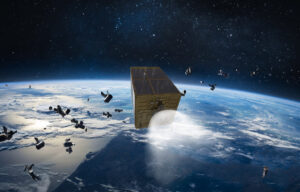Northrop Grumman SBIRS GEO-6 Payload Launched in Support of US Space Force
Tuesday, 09 August 2022 09:45 Northrop Grumman Corporation (NYSE: NOC) has played a vital role in the successful deployment of the missile warning satellite for the U.S. Space Force's sixth and final mission in the Space Based Infrared System Geosynchronous Earth Orbit (SBIRS GEO)-6 program series.
Working in partnership with prime contractor Lockheed Martin, Northrop Grumman designed and built the mission payload, whi
Northrop Grumman Corporation (NYSE: NOC) has played a vital role in the successful deployment of the missile warning satellite for the U.S. Space Force's sixth and final mission in the Space Based Infrared System Geosynchronous Earth Orbit (SBIRS GEO)-6 program series.
Working in partnership with prime contractor Lockheed Martin, Northrop Grumman designed and built the mission payload, whi China receives data from newly launched ecosystem monitoring satellite
Tuesday, 09 August 2022 09:45 China has received data from its newly launched terrestrial ecosystem carbon monitoring satellite, scientists in charge of receiving the satellite data said.
The satellite was carried into space on Thursday by a Long March-4B rocket from the Taiyuan Satellite Launch Center in North China's Shanxi province.
Since Thursday night, ground stations located in Beijing and Xinjiang Uygur au
China has received data from its newly launched terrestrial ecosystem carbon monitoring satellite, scientists in charge of receiving the satellite data said.
The satellite was carried into space on Thursday by a Long March-4B rocket from the Taiyuan Satellite Launch Center in North China's Shanxi province.
Since Thursday night, ground stations located in Beijing and Xinjiang Uygur au Galactic Energy of China registers third consecutive successful launch
Tuesday, 09 August 2022 09:40
TransAstra and Slooh to offer students asteroid detection tool
Tuesday, 09 August 2022 09:00
Space logistics startup TransAstronautica announced a partnership Aug. 9 with online astronomy platform Slooh to offer U.S. schools access to a global telescope network of ground-based and space-based telescopes.
The post TransAstra and Slooh to offer students asteroid detection tool appeared first on SpaceNews.
Tracking marine plastic drift from space
Tuesday, 09 August 2022 07:20
Every 60 seconds the equivalent of a lorry-load of plastic enters the global ocean. Where does it end up? Right now, researchers simply don’t know. But in a bid to help find out, an ESA-led project developed floating transmitters whose passage can be tracked over time, helping in turn to guide a sophisticated software model of marine plastic litter accumulation.
Russia launches Iranian satellite amid Ukraine war concerns
Tuesday, 09 August 2022 07:09 An Iranian satellite launched by Russia blasted off from Kazakhstan early Tuesday and went into orbit amid controversy that Moscow might use it to improve its surveillance of military targets in Ukraine.
A live feed from Russian space agency Roscosmos showed the launch of the Soyuz-2.1b rocket carrying the Khayyam satellite from the Russia-controlled Baikonur cosmodrome at the scheduled time
An Iranian satellite launched by Russia blasted off from Kazakhstan early Tuesday and went into orbit amid controversy that Moscow might use it to improve its surveillance of military targets in Ukraine.
A live feed from Russian space agency Roscosmos showed the launch of the Soyuz-2.1b rocket carrying the Khayyam satellite from the Russia-controlled Baikonur cosmodrome at the scheduled time Benchmark unveils small satellite collision-avoidance kit
Tuesday, 09 August 2022 06:00
Benchmark Space Systems unveiled a collision avoidance kit designed to help small satellites dodge debris and steer clear of other spacecraft.
The post Benchmark unveils small satellite collision-avoidance kit appeared first on SpaceNews.
US should end ISS collaboration with Russia
Tuesday, 09 August 2022 01:30 In the same week that Russians circulated a horrific video of a Ukrainian soldier being castrated before his murder by Putin's invading troops, and dozens of Ukrainians POWs were slaughtered while in Russian captivity, the Russian space agency Roscosmos declared that Russia would depart the International Space Station program "after 2024", while the US Congress authorized NASA to extend the prog
In the same week that Russians circulated a horrific video of a Ukrainian soldier being castrated before his murder by Putin's invading troops, and dozens of Ukrainians POWs were slaughtered while in Russian captivity, the Russian space agency Roscosmos declared that Russia would depart the International Space Station program "after 2024", while the US Congress authorized NASA to extend the prog What part of a space rock survives to the ground?
Tuesday, 09 August 2022 01:30 When a small asteroid enters Earth's atmosphere from space, its surface is brutally heated, causing melting and fragmenting. Therefore, it was somewhat of a mystery why the rocks near the surface survive to the ground as meteorites. That mystery is solved in a new study of the fiery entry of asteroid 2008 TC3, published online in Meteoritics and Planetary Science.
"Most of our meteorites
When a small asteroid enters Earth's atmosphere from space, its surface is brutally heated, causing melting and fragmenting. Therefore, it was somewhat of a mystery why the rocks near the surface survive to the ground as meteorites. That mystery is solved in a new study of the fiery entry of asteroid 2008 TC3, published online in Meteoritics and Planetary Science.
"Most of our meteorites Northrop Grumman teams with Firefly to further develop Antares launcher
Tuesday, 09 August 2022 01:30 Northrop Grumman Corporation (NYSE: NOC) and Firefly Aerospace have joined forces to provide an American-built first-stage upgrade for the Antares rocket and a new medium launch vehicle to serve commercial, civil and national security space launch markets.
"Through our collaboration, we will first develop a fully domestic version of our Antares rocket, the Antares 330, for Cygnus space sta
Northrop Grumman Corporation (NYSE: NOC) and Firefly Aerospace have joined forces to provide an American-built first-stage upgrade for the Antares rocket and a new medium launch vehicle to serve commercial, civil and national security space launch markets.
"Through our collaboration, we will first develop a fully domestic version of our Antares rocket, the Antares 330, for Cygnus space sta The space economy gets major tech advancement with hybrid mobility packages
Tuesday, 09 August 2022 01:30 With hybrid vehicle sales at an all-time high on Earth, Benchmark Space Systems has announced a definitive agreement to acquire Alameda Applied Sciences Corporation (AASC)'s electric propulsion technologies to help power hybrid spacecraft designed to ultimately run on in-space resources and repurposed space debris.
Benchmark's turn-key hybrid chemical + electric propulsion systems will lev
With hybrid vehicle sales at an all-time high on Earth, Benchmark Space Systems has announced a definitive agreement to acquire Alameda Applied Sciences Corporation (AASC)'s electric propulsion technologies to help power hybrid spacecraft designed to ultimately run on in-space resources and repurposed space debris.
Benchmark's turn-key hybrid chemical + electric propulsion systems will lev Ten Earth years later and Curiosity is still exploring Mars
Tuesday, 09 August 2022 01:30 "We've got thumbnails!!" shouted, emotionally, over excited celebrations, is my most intense memory from 10 years ago. I had sat, with a lot of colleagues from my home university, The Open University here in the UK, in a seminar room, NASA TV on the big screen, anxiously watching the proceedings since 6.30 am on the 6th of August. The UK is 8 time zones ahead of Pasadena in California, where it
"We've got thumbnails!!" shouted, emotionally, over excited celebrations, is my most intense memory from 10 years ago. I had sat, with a lot of colleagues from my home university, The Open University here in the UK, in a seminar room, NASA TV on the big screen, anxiously watching the proceedings since 6.30 am on the 6th of August. The UK is 8 time zones ahead of Pasadena in California, where it Lowell Observatory points telescopes at Saturn during closest annual approach
Tuesday, 09 August 2022 01:30 Saturn will soon be at its biggest and brightest of the year, and Lowell Observatory is celebrating with nightly public telescope viewing. For the next several weeks, visitors will be able to gaze at this gas giant and see its dazzling system of rings, as well as some of its larger moons.
This Saturn viewing season centers around the planet's August 14 opposition. The term opposition indic
Saturn will soon be at its biggest and brightest of the year, and Lowell Observatory is celebrating with nightly public telescope viewing. For the next several weeks, visitors will be able to gaze at this gas giant and see its dazzling system of rings, as well as some of its larger moons.
This Saturn viewing season centers around the planet's August 14 opposition. The term opposition indic Stars shed light on why stellar populations are so similar in Milky Way
Tuesday, 09 August 2022 01:30 Scientists have uncovered what sets the masses of stars, a mystery that has captivated astrophysicists for decades. Their answer? Stars, themselves.
Using highly detailed simulations, a collaborative team led by researchers from the University of Texas at Austin has made a breakthrough discovery that star formation is a self-regulatory process, knowledge that may allow researchers to under
Scientists have uncovered what sets the masses of stars, a mystery that has captivated astrophysicists for decades. Their answer? Stars, themselves.
Using highly detailed simulations, a collaborative team led by researchers from the University of Texas at Austin has made a breakthrough discovery that star formation is a self-regulatory process, knowledge that may allow researchers to under Stars determine their own masses
Tuesday, 09 August 2022 01:30 Last year, a team of astrophysicists including key members from Northwestern University launched STARFORGE, a project that produces the most realistic, highest-resolution 3D simulations of star formation to date. Now, the scientists have used the highly detailed simulations to uncover what determines the masses of stars, a mystery that has captivated astrophysicists for decades.
In a new s
Last year, a team of astrophysicists including key members from Northwestern University launched STARFORGE, a project that produces the most realistic, highest-resolution 3D simulations of star formation to date. Now, the scientists have used the highly detailed simulations to uncover what determines the masses of stars, a mystery that has captivated astrophysicists for decades.
In a new s 
